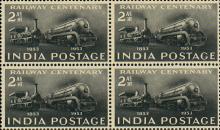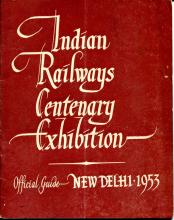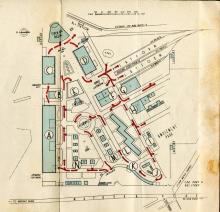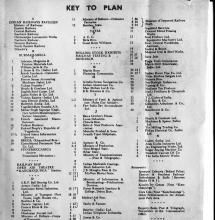Whether it is the life span of a human being or the completion of 100 runs in cricket, a century is a century and is always a significant event. In 1953, when the railways in India completed a century of commercial operations, the newly constituted Indian Railways celebrated the milestone in more ways than one. One was the issue of a postage stamp along with an Indian Railways Centenary First Day Cover. The stamp shows the locomotive “Express” on the left and a WP on the right. The Express (No. EIR 21) was a sister of the Fairy Queen (No. EIR 22) and both had been pressed into service in 1855 on the East Indian Railway. The Fairy Queen has been certified by the Guinness Book of Records as the world’s oldest locomotive in working order. The WP was a Pacific type steam locomotive, suitable for passenger train working. The first 16, built by Baldwin Locomotive Works, Philadelphia, had been inducted in 1947, by the fledgling Indian nation. 300 more were in service by 1953. Later built in India by the Chittaranjan Locomotive Works, the WP was the mainstay of passenger train operations till the advent of diesel and electric behemoths. The First Day Cover has a sketch of a WP locomotive as well as one of GIP-1, one of the first eight locomotives that had been delivered to the Great Indian Peninsular Railway. Three of these locomotives, Sindh, Sahib and Sultan, worked the first train in the country on the 16th of April 1853.
The main event to commemorate and mark the historic event was held at the Railway Exhibition grounds at New Delhi on the 16th of April 1953, exactly hundred years after the first train run from Bori Bunder to Thane in Bombay (now Mumbai). The then Vice President, Dr. S. Radhakrishnan, deputising for the President, an indisposed Dr. Rajendra Prasad, was received at the ceremonial platform on State Entry Road by the then Minister for Transportation and Railways, Mr. Lal Bahadur Shashtri, and other dignitaries. The party was moved to the exhibition grounds by a special train arranged for the purpose. An interesting invitee to the function was the then longest serving employee of the Indian Railways, Mr. Durga Manoo, who had been recruited by the Indian Midland Railway way back in the year 1900. This may appear a very short service for the oldest person today, but we should remember that the retirement age then was a mere 55 years.
Similar commemorative functions were arranged at virtually all headquarters of the newly formed zonal railways. There were only six zonal railways then – Central, Eastern, Northern, North Eastern, Southern and Western – against the 17 zones that exist today. The most impressive function was conducted at Victoria Terminus in Bombay, the site of the first train run that was being commemorated.
Apart from special functions on the 16th of April of 1953, a Centenary exhibition was also organised to mark not only the completion of 100 years of the railways in India but also to show case the contribution of the railways towards the continuous progress in the country. The following is an extract from the “Railways Centenary Exhibition – Official Guide, New Delhi 1953”.
“Today the Indian Railways cover a vast network of 34,123 route miles and operate as the single largest nationalised undertaking in the country. Bigger than other systems in Asia, and ranking fourth in the World, Indian Railways are now, more than in the past, playing a pivotal part in the economic and social life of the people.
“The Central theme of the Centenary Exhibitionis to portray this progress of the Indian Railways and the services they render. The Exhibition is an endeavour to inform the people, who own and patronise the Railways, about how the railways function, of the technical and industrial effort in the public and private sectors that lie behind the railways undertakin, and the measure of self-sufficiency that has been achieved so far.
“The story is told in the many pavilions and stands of the Exhibition and by a display of the units of the Rolling-Stock that have been, and are, in use on the Railways. A Museum has also been speicially organised showing the many railway components that are still being imported by the Indian Railways so that Indian Manufacturers could study the spcialised railway requirements and undertake manufacture within the country.
“The Exhibition has been located at a site* on the Mathura Road and railway sidings from Hazrat Nizamuddin Station have been laid for the display of the rolling-stock. Adjoining the PUrana Qila, the site itself is of interest. History hovers in the surroundings. Monuments recalling the far and the near past overloo the Exhibition. A fitting back-grond is provided by the passing of the main line trains on the Delhi-Mathura route.”
A site map of the exhibition and a key to the various stalls that also appeared in the official guide is shown alongside. It should be remembered that it was then only a trifling six years since the nation became independent and had already seen a war over the Northern province of Kashmir. The key reads like a Who’s Who of Indian industry and indicates that of all the Ministries and Departments of the Government of India, the railways were perhaps the first to find their feet and lead the way to development.
Of interest to followers of the history of Delhi, is the list of special buses that were run by the Delhi Transport Service from the Exhibition grounds. These would indicate the population centres that were prevalent in Delhi then. Buses (Route Numbers in brackets) ran to the following terminal stations:
Okhla (18), Lajpat Nagar (29), Lodi Road (19), Karol Bagh (24), New Cantonments (3A), Pusa Institute and West Patel Nagar (7), Tis Hazari (10), Hauz Qazi (14), Birla Mills (15A), Tilak Nagar (26A), Malviya Nagar and Vinay Nagar (28A), Delhi Junction station (18, 18A, 29)
*It is interesting to note that this very site was later christened “Pragati Maidan” and became the centre for large conventions and exhibitions in New Delhi.




